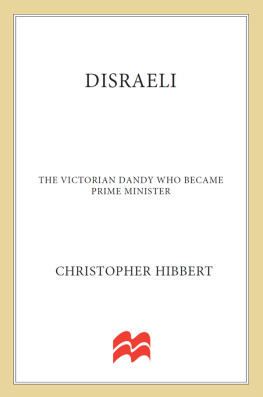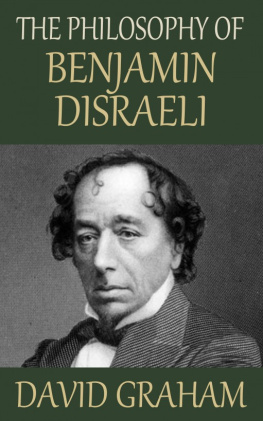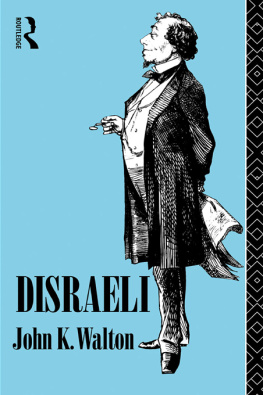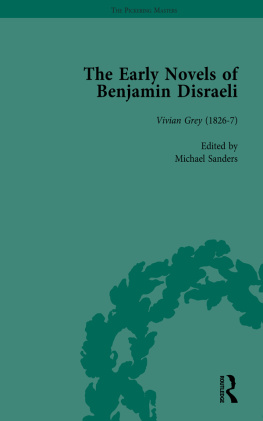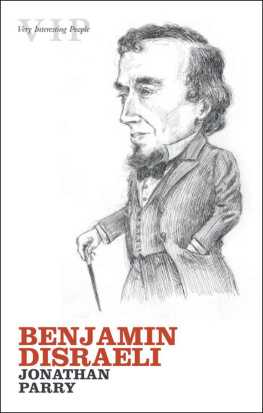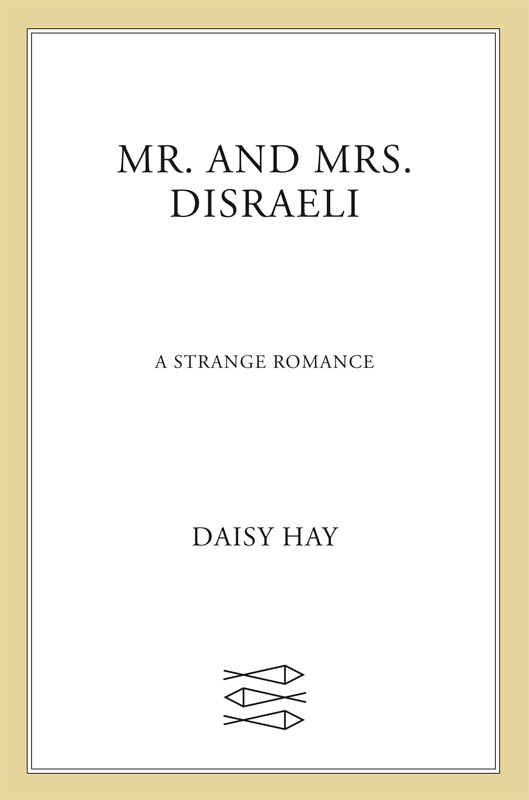Contents
Guide

The author and publisher have provided this e-book to you for your personal use only. You may not make this e-book publicly available in any way. Copyright infringement is against the law. If you believe the copy of this e-book you are reading infringes on the authors copyright, please notify the publisher at: us.macmillanusa.com/piracy.
For Matthew and Freddy
My wife is a very clever woman, Disraeli is reputed to have said, but she can never remember who came first, the Greeks or the Romans. Benjamin and Mary Anne Disraeli are figures around whom anecdotes coalesce: about what they wore, what they did and what they said. Mary Anne apparently told Queen Victoria that she always slept with her arms around Disraelis neck. Disraeli, when asked if he had read a new novel, is rumoured to have replied, When I want to read a novel I write one. If one were to read something other than a novel one had written, he had views about what that work should be too. Read no history: nothing but biography, for that is life without theory.
When the Disraelis were born, government was organised according to aristocratic faction; they died in the era of professional politics. In their lifetimes Britains empire grew until it covered swathes of the globe. They witnessed the development of rail travel, photography and the telegraph, and the transformation of their country from an agricultural to an industrialised nation. Their story is history, despite Disraelis disavowal of the subject. But it is also a fiction. Those who disliked them thought their romance artificial, its grand gestures contrived. Those who were fond of them thought there was something fantastic about their good fortune. They themselves spun stories around their partnership, but they also made the tales they spun come true.
This book is about the way in which the Disraelis conjured their romance into being in a world thick with stories. In their youth they read versions of themselves in the epistolary novels of the late eighteenth century; in the 1820s and 30s they saw their aspirations reflected in the silver-fork novels Disraeli and his literary contemporaries produced at great speed. They were middle-aged when the Victorian novel came to maturity in the 1850s, the literary form that finds drama in the everyday. Theirs was thus the great age of fiction, when the novel made a romance of reality and turned ordinary men and women, living ordinary lives, into heroes and heroines.
Both were born storytellers. As an old lady resplendent in jewels and bright fabrics, Mary Anne pretended to have worked in her youth as a milliner or, in her more creative moments, as a barefooted factory girl. Disraeli, the sober-suited statesman, invented for himself an illustrious ancestry featuring an ancient family who escaped from Spain to Venice and then to England. Both were also keepers of stories. Mary Anne was a skilled and dedicated collector of documents, and the results of her impulse to collect and curate are visible today at the Bodleian Library in Oxford, where the Disraelis papers are held. These papers constitute an archive of unparalleled richness, numbering over 50,000 separate items. The political sections of this archive have been extensively studied by scholars of Disraeli, but the 10,000 items relating specifically to Mary Anne have historically received little attention. Yet the archive in its entirety represents Mary Annes great creative achievement. That we can recover so much of her and Disraelis biographies is due to her efforts to catalogue the various chapters of their lives.
* * *
This book traces the intertwined story of Mr and Mrs Disraeli through their papers. My sense of their archive and the story it reveals has evolved over the course of several years of immersive reading in the Special Collections Reading Room at the Bodleian Library. These years have been among the most stimulating of my professional life. They have also been the coldest, courtesy of the relocation of the Bodleians manuscript holdings to a temporary reading room in a minimally heated and underinsulated 1950s basement. This relocation means that at the time of writing you have to be a hardy creature to work on a Bodleian manuscript in winter, or to be amongst the heroic Special Collections Reading Room staff.
The cold of the Special Collections Reading Room has opened up the Disraelis history for me in unexpected ways. Their letters are full of references to being cold; to the way in which the cold confines the body and chills the mind. At Stowe House, while waiting to meet the Queen, they shiver in draughty halls and inadequate evening garb. At Osborne, the Queens house on the Isle of Wight, he wears two greatcoats and a waistcoat as protection against the elements. Disraelis father Isaac will not stir from his fireside in winter, even for the fresh air the doctor has ordered; his sister Sarah is compelled to cancel excursions to London when the east wind whistles through her hired carriage. Mary Annes servants run back and forth from the House of Commons with warm clothes and boots to protect Disraeli from the chills of the debating chamber, until snow stops carriage wheels from turning and forces both master and mistress to stay inside.
Cold is also present in the Disraelis papers in less physical ways. In 1792, the year of Mary Annes birth, the steel of the guillotine glints for the first time in France and the French King, Louis XVI, is arrested, imprisoned and tried for his life. By the time of Disraelis birth in 1804, Britain and France have been fighting for over a decade and war has become the sullen backdrop to the affairs of the nation. In this climate, free speech is not a luxury the government is prepared to afford its citizens, and political dissenters are spied on, arrested, and hounded out of their homes and their country by the rough justice of the mob. Mary Anne is the daughter of a sailor; Disraeli is of Jewish descent. Yet for all the insecurity of their beginnings they become, over the course of their lives, able to shelter themselves from the cold, in both its physical and metaphorical manifestations.
* * *
The Disraelis biographies are not the only narrative to emerge from their papers. Much of the reading I did over the course of my winters in the Bodleian was of letters written to Mary Anne by women who have disappeared from history. Taken together, the cases of these women point to the elements of the Disraelis story that were at once universal and exceptional. They show how unusual Mary Anne was, as they reveal the vulnerability of those in her circle of acquaintance who were unmarried, widowed, or compelled to remain in unhappy households by convention and circumstance. Mary Anne understood the stories of less fortunate women as a counterpoint to her own and in that spirit they appear throughout this book, shadowing its central romance. Disraeli too derived his sense of self and his place in the world from paper. His shadows were not people he knew but Byron and Shelley, his literary forefathers. He was one of the last Romantics, shaped by the power of his own romance and the books he read.
Disraeli has, of course, been much written about by historians and biographers. Robert Blakes 1966 biography remains definitive, and has been joined in recent decades by a host of other works, including a rich study of Disraelis early life by Jane Ridley and a provocative account of his sexuality by William Kuhn. Those who wish to trace the thinking of this most mercurial of men can do so through his letters, magnificently edited by the scholars of the Disraeli Project at Queens University, Canada. Mary Anne has herself been the subject of two short biographies by James Sykes and Mollie Hardwick, published in 1928 and 1972 respectively. Sykes wrote when myth still obscured Mary Annes origins, and he concentrated his efforts on separating fact and fiction in her own retellings of her story. In Mrs Dizzy , Mollie Hardwick brought a novelists eye to Mary Annes history and collated many anecdotes relating to her conversational style, which was quite unlike that of her contemporaries.


